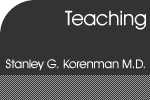

|
<< Previous Section | < Previous Page | Next Page > | Next Section >>
Bibliography (page 1 of 5) (2004). Clinical Trials on Trial. The Wall Street Journal. New York. March 3, 2004 Kennedy, D. (2006). "Editorial Retraction." Science 311(5759): 335b-. This formally retracts the editorial about human stem cell cloning previously published in Science. Normile, D., G. Vogel, et al. (2006). "CLONING: South Korean Team's Remaining Human Stem Cell Claim Demolished." Science 311(5758): 156-157. This news report in Science describes in some detail the investigation of Dr. Hwang's research and the conclusion that human stem cell lines did not exist but that the cloning of a dog did take place. Agres, T. (2002). "Science on the Sly: Guilty plea in Cleveland Clinic case becomes latest example of theft from research labs." The Scientist Summer: 16-18. This unusual case involves the stealing and transfer of scientific materials from one lab to another and then out of the country. The perpetrator was accused of economic espionage, altering and destroying trade secrets, and interstate and international transfer of stolen materials. This case underscores the increasing value of research materials and the need for security even in academic labs. The irony is that these materials could have been shared under a material transfer agreement. Baltimore, D. (1993). "Shattuck Lecture--Misconduct in Medical Research." N Engl J Med 329(10): 732-3. Barinaga, M. and J. Kaiser (1999). "MISCONDUCT:Fraud Finding Triggers Payback Demand." Science 285(5431): 1189a-1190. This news report indicates that the National Cancer Institute asked the Lawrence Berkeley national labs for a return of $800,000 in research funds when they exposed allegedly fraudulent research by a colleague. The work had put electromagnetic fields in play as influencing cellular function. The lab agreed to return unspent money but not the whole grant. Brody, J. (2004). A Top Scientist's Research is Under Attack. The New York Times. New York, NY. May 6. A major nutrition investigator's work was published then seriously challenged as being statistically invalid. The investigator was supporting the use of a vitamin preparation that he designed for cognitive maintenance and licensed to his daughter's company. He left Canada and moved to India after the news broke. Dayton, L. (2002). "Scientific misconduct. Hall probe continues; no 'willful' fraud." Science 296(5568): 641. This report of an Australian case in which allegations of willful conducting scientific fraud were lodged against a prominent clinical investigator. Although he was reprimanded and asked to do some restitution, he was not judged to having committed research misconduct pending a second investigation. A lesson for those who run laboratories. Ding, Y. (2002). "SCIENTIFIC MISCONDUCT: Beijing U. Issues First-Ever Rules." Science 296(5567): 448-. These parallel western rules regarding research. Enserink, M. (2003). "NEUROSCIENCE: Singapore Trial Halted, British Scientist Fired." Science 300(5617): 233a-. The PI, a well known neurologist was found to have misled subjects as to the research protocol and provided an inadequate consent. He also obtained the names of potential subjects and called them directly, violating their privacy rights. Fitzgerald, M. H. (2004). "Big Basket or Mission Creep?" Professional Ethics Report 17(2). << Previous Section | < Previous Page | Next Page > | Next Section >> |
Chapter 8 Quick Links Malfeasance and Misconduct Definitions Process Whistleblowing Litigation, the New Approach to Research Management The Importance of Trust Cases Bibliography Chapter 8 Download (PDF) |